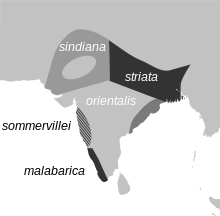Jungle babbler
| Jungle babbler | |
|---|---|
 |
|
| Turdoides striata striata | |
| Scientific classification | |
| Kingdom: | Animalia |
| Phylum: | Chordata |
| Class: | Aves |
| Order: | Passeriformes |
| Family: | Leiothrichidae |
| Genus: | Turdoides |
| Species: | T. striata |
| Binomial name | |
|
Turdoides striata (Dumont, 1823) |
|
 |
|
| Synonyms | |
|
Turdoides striatus |
|
Turdoides striatus
Malacocercus terricolor
Cossyphus striatus
Crateropus canorus
The jungle babbler (Turdoides striata) is a member of the family Leiothrichidae found in the Indian subcontinent. They are gregarious birds that forage in small groups of six to ten birds, a habit that has given them the popular name of Saath bhai (seven brothers) in Bengali with cognates in other regional languages which also mean "seven brothers".
The jungle babbler is a common resident breeding bird in most parts of the Indian subcontinent and is often seen in gardens within large cities as well as in forested areas. In the past, the orange-billed babbler, Turdoides rufescens, of Sri Lanka was considered to be a subspecies of jungle babbler, but has now been elevated to a species.
The jungle babbler's habitat is forest and cultivation. This species, like most babblers, is non-migratory, and has short rounded wings and a weak flight. The sexes are identical, drably coloured in brownish grey with a yellow-bill making them confusable only with the endemic yellow-billed babblers of peninsular India and Sri Lanka. The upperparts are usually slightly darker in shade and there is some mottling on the throat and breast. The race T. s. somervillei of Maharashtra has a very rufous tail and dark primary flight feathers.The jungle babbler can be separated from the white-headed babbler by the dark loreal zone between the bill and the eye as well as the lack of a contrasting light crown. The calls of the two species are however distinct and unmistakable. The jungle babbler has harsh nasal calls while the white-headed babbler has high pitched calls. Another babbler that is similarly found in urban areas is the large grey babbler, however that species has a distinctive long tail with white outer tail feathers.
...
Wikipedia

